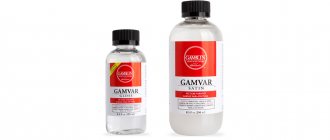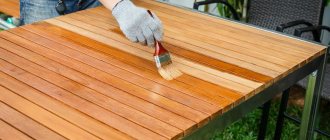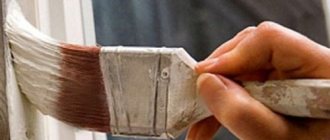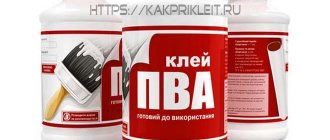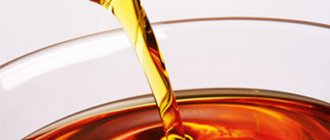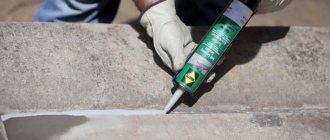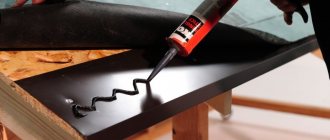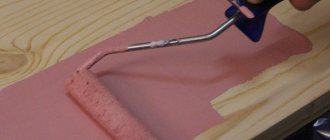Varnishes for oil painting are divided into 4 main groups according to their purpose. These include: topcoat varnishes, intended for treating the surfaces of finished paintings, binders - to strengthen the painting layer, thinning varnishes - used to dilute the paint mass, and universal ones, having a multifunctional purpose. Let us dwell in more detail on the features of topcoat dammar varnish, one of the most popular and widespread.
Color fading in the sun
It is known that the disadvantage of most dyes, both used in everyday life and used in industrial production, is their poor resistance to sunlight. The result of this is faded and faded clothing fabrics, room wallpapers, street banners and many other things around us. They usually say about them: “Burned in the sun.”
A similar fate will befall oil paintings on canvas if the artist does not take care to preserve their original appearance. The traditional method, used since time immemorial, is to coat finished paintings with special varnishes that can protect them from exposure to sunlight. They were invented a long time ago, and their composition has changed and improved many times over the centuries.
Acrylic styrene varnish
Acrylic-styrene varnish is considered to be an analogue of acrylic-pistachio varnish. It has all the same properties as pistachio acrylic and perfectly protects the painting from water.
All these topcoat varnishes give the paintings a glossy shine. Not all artists like this, and then matte varnishes come to the rescue. Having the same properties, they protect the picture in the same way as glossy ones, but do not make the colors brighter or more saturated. In addition to topcoat varnishes, there are also so-called painting varnishes. They are mixed with oil paints and paintings are painted with this solution, making the paint layer more durable.
What is dammar varnish used for?
These days, the chemical industry offers painters a wide range of means to protect their works. One of the most common among them, as mentioned above, is dammar varnish. Applied in a thin layer, after drying it not only creates a protective film that protects the painting layer from the unwanted effects of ultraviolet rays of the solar spectrum, but also gives the overall color of the picture greater brightness and depth. In addition, thanks to it, small details depicted on the canvas look more clear and textured.
Another important feature of dammar varnish is its ability to resist moisture. If the painting is stored in a room where its air content is high, the paint may begin to peel off the canvas and fall off. No less detrimental is the effect on the unprotected pictorial layer of excessively low indoor humidity. In this case, it may crack and begin to crumble. Canvases on which the paint is applied in a thick, thick layer are especially susceptible to this danger.
In addition to all of the above, oil paintings on canvas may be subject to such negative influences as sudden changes in temperature, settling of dust, and the ingress of liquids and gases onto their surface. Thus, coating the finished painting with dammar or some other protective varnish is an integral part of the overall process of creating a painting.
Properties of fixative varnish
Compared to other topcoat varnishes, it has a softer consistency when drying and a light texture, due to which it does not weigh down the paper on which it is applied. Unlike traditional topcoat varnishes, it does not crack when the shape is slightly deformed. It seems to glue particles of dry material to the sheet and form a protective film.
The fixative is almost invisible, but in addition to reliably protecting against shedding, it also allows you to clean your work from dust, stains and dirt without loss or smearing of the material.
Legacy of past centuries
The main component of dammar varnish is a resin of plant origin, which gives it its name. It belongs to the group of soft, alcohol-soluble resins, on the basis of which the production of varnishes was mastered back in the 17th century. It is known that artists often used them not only to cover finished works, but also added them to oils, thereby ensuring that the paints dried as quickly as possible.
It is known from the history of art that many masters of past centuries used balms and essential oils (resin) made from soft resins (including dammar) in their work. The most famous among them are Venetian, as well as Strasbourg terpine and copai balsam. All of them gave a positive effect when used with regular drying oils.
Varnish manufacturers
Among varnish manufacturers, the most famous is SONET. The varnishes from this manufacturer are not expensive, but at the same time they have good functionality, but are difficult to apply, so they are ideal for experienced artists.
, REVEES varnish is more suitable . It is identical in price to SONET , but is much easier to apply and creates an even coating.
A more expensive and durable option is a product from the French manufacturer Lefranc Bourgeous . It will truly preserve the beauty of your work for many years to come.
for beginners
Effect achieved with resin ingredients
It has long been noted that resin ingredients, which have high transparency and reflective properties, can give paintings additional brightness and depth. In addition, they significantly improved the performance characteristics of oil paints, opening up new possibilities for creating spectacular lasses on canvas.
This term refers to a technique in which, by applying translucent paints over the base color, the effect of deep color tints is achieved. Among the masters of the past, such luminaries of painting as Velazquez, Titian, Rembrandt and Leonardo da Vinci achieved the greatest perfection in it.
Coating varnishes
Coating varnishes are used for coating, oil and tempera painting.
Pistachio varnish
is a solution of pistachio resin (23%) in pinene with a slight addition of white spirit (thinners No. 2) and butyl alcohol.
The advantage of pistachio varnish is the almost complete colorlessness of the varnish film, which is highly elastic. The drying speed of pistachio varnish is significantly lower than that of other topcoat varnishes. Acrylic-pistachio varnish
is a synthetic polybutyl methacrylic resin with the addition of a small amount of pistachio resin.
The resins are dissolved in pinene, to which about two percent butyl alcohol has been added. The film of acrylic-pistachio varnish is almost colorless, has great elasticity and is superior in strength to films of mastic and dammar varnish. Drying occurs more slowly than mastic varnish. Retouching varnish
is used to prevent fading during multi-layer oil painting, as well as to enhance the adhesion of paint layers. The varnish can be applied with a brush or swab. The varnish consists of 1 part mastic varnish and 1 part acrylic-pistachio varnish, dissolved in 8-10 parts of aviation gasoline.
Making your own varnish
Dammar varnish can be purchased in stores specializing in products of this profile. One of its undeniable advantages is its accessibility and low cost. However, many artists prefer to make it with their own hands, introducing their own innovations to the standard technology. Without touching on their professional secrets, we will consider only the generally accepted version of this process.
The main component of the varnish is dammara resin, supplied to Russia from Singapore. Externally, it looks like small transparent straw-colored granules, coated on the outside with a thin layer of crushed powdery substance.
Brand manufacturers
Usually varnishes are produced by the same manufacturers that sell paints. This is a budget "Sonnet" or a little better - "Reeves". A little more expensive there are “Master Class” and varnishes from various foreign manufacturers. These include "Amsterdam", "Galeria" or "Vallejo".
In particular, the best acrylic-styrene varnish is produced in Russia. This is a manufacturer from St. Petersburg, producing several lines, including the aforementioned “Sonnet”, the well-known “Master Class” and “Ladoga”.
Varnishes are most often sold in bottles of 120 milliliters or in aerosols, as in the case of fixative and acrylic-styrene, of 210 milliliters. Bubbles in stores for artists cost on average about 200-350 rubles. It depends on its ingredients and manufacturer.
In classical art, which includes painting, a thorough approach is important. Poor quality materials, skipping any stage of the process, neglect of tools - all this will be reflected in the final product. Paints must be carefully selected, having studied their properties in advance, stretched evenly and properly glued and primed the canvas, spread the “tee”, or buy ready-made and, of course, cover the painting with a layer of protective varnish after it is completely dry. The result will be a well-made and culturally designed work.
Painting varnishes are 30 percent solutions of resins in pinene, with the exception of copal varnish, where copal resin is dissolved in linseed oil.
The following types of varnishes are produced, used as additives to oil paints: mastic, dammar, pistachio, acrylic-pistachio and copal. Mastic varnish.
A 30% solution of mastic resin in pinene.
Mastic varnish can serve not only as an additive to paints, but also as a wiper for intermediate layers during layer-by-layer painting, replacing retouch varnish in this. Mastic varnish is also used as a topcoat for oil and tempera painting. It tends to turn a little yellow over time. Gives your work a glossy finish. Very elastic. Dammar varnish
.
A 30% solution of dammar resin in pinene with the addition of ethyl alcohol. Dammar varnish is used as an additive to paints and as a topcoat. During storage, it sometimes loses transparency, but when it dries, when pinene evaporates, the varnish film becomes transparent. Pinene is used to dilute varnish. When aging, dammar varnish turns yellow less than mastic. Copal varnish
is an “alloy” of copal resin and refined linseed oil, diluted with pinene.
Dark varnish. Approximate composition of varnish (in ppm): copal - 20, oil - 40, pinene - 40. The varnish is used as an additive to paints. The dried film of copal varnish is insoluble in organic solvents. In addition to the above varnishes, the following are available: balsam-oil, cedar, balsam-penta-oil and fir varnish
A recipe available to everyone
Having previously crushed the resin, it is placed in a small bag made of thin cotton fabric (for example, an old stocking is quite suitable), and then dipped into a solution of artistic turpentine for several hours. It is important to note that the container with turpentine must be tightly closed during this entire period.
While in turpentine, the pre-crushed granules dissolve, and all solid impurities settle at the bottom of the bag. The result is a solution of dammar resin, which should then be carefully filtered through muslin or cotton cloth.
An important role is played by the ratio of the amount of dissolved resin to the volume of turpentine, since the concentration of the finished product depends on this. According to generally accepted standards, it is 600 ml of turpentine per 300 g of resin, however, many of those who prefer to prepare the solution with their own hands create the proportions of the components based on personal experience. In the future, if during the process of applying the varnish to the surface of the painting it turns out to be too thick, it can be diluted with alcohol.
Why pin a job?
Varnishing provides the painting with a long life. This saves it from deformation, fading, cracks, chips and paint falling off the canvas. Secure the painting with topcoat varnish. How long it will last in its most presentable form without damage depends on this.
Painting varnish creates a protective film, most often glossy, but not always. In addition to protecting against the effects of temperature, light, humidity, cracks and shedding, it protects from dust, leaving the picture bright. It is much easier to remove dirt and dirt from a varnished surface. They will not be able to harm or distort the properties of paints and coatings.
It can also improve the picture - make the colors fresher and brighter, and the coating more uniform and pleasing to the eye. It is he who gives the work an element of completeness. An unvarnished painting does not correspond to the culture of presentation of the work.
When can a painting be coated with dammar varnish?
This issue is extremely important, since violations of technology caused by ignorance or negligence can lead to damage, and in some cases, to the death of a painting. First of all, after completing the painting, you should not rush, since the linseed oil contained in the paints must have time to polymerize, that is, when completely dry, it must turn into a solid polymer. How long does it take?
Even in the recent past, it was customary to cover paintings with dammar, and equally with any other varnish, no earlier than a year after their completion. During all this long time, the canvases had to be carefully protected not only from dust and dirt, but even from tobacco smoke.
Nowadays, artists use paints made on the basis of modern technologies, providing them with greater durability and reducing drying time. In view of this, the minimum period of time between finishing the painting and coating it with varnish has been reduced and ranges from one to one and a half months.
How to choose the right varnish
The choice should be based on the goals pursued. To do this, you need to know what is good about each variety. Topcoat varnishes are needed to protect the painting and are applied after finishing the work.
Pistachio varnish
Made from pistachio resin. It has many advantages: it is durable, lays down tightly in an invisible layer, does not become cloudy and does not change color over time. In addition, it is of natural origin and non-toxic. The only serious disadvantages of pistachio varnish are the very high price. It's also a rarity in art stores.
Dammar varnish
(including fir) - the most popular option among art students in their first years at schools and academies. It reliably protects your work from dust and damage, and is very cheap. Dammar varnish is bad in that over time it acquires a yellowish tint, which will certainly be superimposed on the picture. However, this property can be used to your advantage.
Acrylic-styrene varnish
It has a synthetic base, due to which it has high water-repellent properties. In addition, it applies tightly and evenly, dries quickly, behaves predictably, does not change color, does not become cloudy, and protects against dust.
Fixative is used to secure works made with dry, crumbling materials: pastel, charcoal, dry sauce, sanguine and others. It is lighter than other types, is applied with a thin, light film and protects against shedding and smearing.
Retouching varnish is thinning. It is used not to protect the painting, but to dissolve the previous coating without damaging the paint layer and continue working on it.
Varnishes are not only glossy, but also matte, which do not glare in the light. They differ from glossy ones in that they are not able to make colors purer and richer or otherwise change their properties. To test the varnish, you need to apply it to a smooth surface. A good coating should lie evenly and not stick when dry.
According to reviews of acrylic-styrene varnish, it is the most effective for protecting paintings. It is the most balanced in terms of price and quality, and can very often be found on the shelves of stores for artists.
How to cover a painting with dammar varnish?
The basic rule is that when applying a layer of varnish, you should not rush, since with rapid movements the brush inevitably captures air, leaving microbubbles on the canvas, forming cloudy whitish stripes. If this does happen, it is recommended to remove the unsuccessfully applied layer of varnish using thinner and then try again.
After varnishing is completed, the painting should be placed on a flat horizontal surface and applied for 10-15 minutes. Allow the still liquid varnish to spread evenly and harden slightly. Then it is hung in a room with good ventilation. The drying time for dammar varnish is 12 hours. Accordingly, during this period it is better not to touch the painting and protect it from dust.
Acrylic styrene varnish: properties
This coating material also has its own characteristics and differences from classic dammar and those made of resins.
Like a fixative, acrylic-styrene varnish does not lay down as a crust, but as a transparent flexible film, so it can be applied between layers for better adhesion to prolong the life of the painting.
It can be used when working with different materials: oil paints, acrylic and tempera. If desired, it can be removed from the surface of the painting with a special solvent or white spirit.
In addition, acrylic-styrene varnish has a powerful water-repellent effect, protecting the paint layer from moisture, due to which it can become damp, fade and fall off.
The coating can be applied only after the paint has completely dried; the varnish itself sets and hardens within 24 hours.
In addition to the usual bottle, stores sell acrylic-styrene varnish in the form of an aerosol.
A few more tips
There is one more important detail that may escape the attention of a novice artist - the shelf life of dammar varnish. If you do not make it with your own hands, as described in one of the previous sections of our article, but buy it in a store, then you should take into account that after 3 years from the date of release it largely loses its properties.
As a result, the varnish layer may not dry completely and the surface will remain sticky for a long time. Dust will settle on it and cannot be removed. To avoid this problem, you need to make sure that the varnish you purchase is fresh, since it could last indefinitely in an art salon. Old varnish can be added to paint to achieve painterly effects, one of which was discussed above.
At the end of the article, it should be mentioned, firstly, that dammar varnish is fire and explosive, therefore it should be handled with the necessary precautions in such cases. And secondly, it has a very negative property of turning yellow over time. In view of this, they are not recommended to cover paintings made in cold colors. This effect is shown in the last photo.
Ghenadie Sontu Fine Art
Most widespread both in modern painting and in the painting technique of masters of the 11th–18th centuries. received oil varnishes. Turpentine varnishes began to be used by painters only in the 16th century, with particular success until the 18th century. not having. In the 19th–20th centuries. turpentine varnishes are very popular as a coating material and as a binder. Alcohol varnishes, which are a solution of resin in alcohol, are not widely used in painting techniques due to their low strength and durability. The film of alcohol varnishes, consisting of alcohol solutions of resins, very quickly becomes covered with cracks, in addition, it is not durable and has very little durability.
Oil varnish is the most common and valuable material. It is used both as a coating agent to protect paintings from destruction, and as a binder for paints.
In the painting technique of the old masters, oil varnishes occupied one of the first places since the 11th century. In the earliest periods of the development of oil painting, these varnishes were used exclusively for coating. Oil varnishes, however, not only protected the surface of paintings from destruction, but also gave the paintings a completely finished look. In the 17th century, at the time of the flowering of oil painting techniques, oil varnishes found their use as a binder for paints.
Oil varnishes, as already noted, are solutions of one or another resin in oil. Famous Flemish painter of the late 16th – early 17th centuries. Peter Paul Rubens used resins: mastic or turpentine in the binder of his paints - well-bleached by the sun and condensed oil.
Italian painters of the XV-XVII centuries. Oil varnishes made from light resins were also used as a paint binder. We can confidently speak in this regard about Leonardo da Vinci. In his treatise on painting techniques, he directly pointed out the need to prepare paints using oil varnish. Oil varnishes were also used as a binder by such outstanding medieval painters as Titian, Raphael, Rembrandt and others.
This widespread use of oil varnishes as a binder is explained, according to prof. Petrushevsky, in that varnishes better protect paints from the action of air, slow down the process of oxidation and destruction of the paint layer, the resin included in the varnish gives the paints purity and immutability of the original tones.
The role of oil varnishes in painting is significant. Thanks to their coating of the surface of paintings, the vast majority of works of art by old masters have been preserved quite well to this day, and the use of oil varnish as a binder for paints contributed to the great strength and unique preservation of these masterpieces.
are a necessary component of varnishes . They have a significant impact on the nature of the physical and chemical processes occurring during the formation of the varnish film, as well as the paint layer (in the case of the inclusion of resin or varnish in the paint binder).
In plants, mainly conifers, when the bark is naturally or artificially damaged, a liquid is released, which over time, under the influence of light and air, turns into resin-forming substances of various types and hardness. Resins in their chemical composition are complex substances consisting of compounds of carbon, hydrogen and oxygen, and contain mainly free resin acids, resin alcohols - esters, unsaponifiable compounds - resins, related to neutral compounds and (in some resins) dyes.
Natural resins are divided into hard and soft . The first include amber, copal, the second - dammara, mastic, pistachio . Of the resins produced artificially, acrylic can be called.
Amber is the most ancient fossil resin of the oldest coniferous trees. It is found on the shores of the Baltic Sea, Dnieper, Neman, Vistula, Sakhalin and other places.
The best varieties of amber are among the hardest resins. Different types of amber begin to melt at different temperatures, from 250 to 300 °C and above, their color ranges from light yellow to dark, they can be transparent or cloudy. Amber in its natural form is insoluble in oils and in solvents. In Russia it began to be used in the 17th century.
Copal is also a fossil resin used in painting since the 17th century and varies in hardness depending on location. The hardest resin is considered to be Zanzibar copal (East Africa); The mildest types include copal kauri and manila (New Zealand, Australia), as well as those obtained from currently growing trees. In the USSR, copals were found in Transcaucasia and the Far East. It should be noted that copals extracted from plants are inferior in quality to fossils.
Copals come in light and dark yellow, as well as brown. Copals in their natural form are not soluble in oils. They are also insoluble in solvents. The exceptions are Maltese and cowrie, which dissolve in wine alcohol and when heated in oil. Hard copals melt at a temperature of 300 °C, soft copals - at 130–180 °C.
Dammara began to be used in painting only in the second half of the 19th century. It is obtained from plants growing in Indonesia and some other places. The best varieties of dammara are colorless and easily dissolve in turpentine and heated oil; only a certain part of the resin dissolves in alcohol. Dammara melts at a temperature of 80–100 °C.
Mastic (mastic) has been used by artists since the 17th century. This type of resin is extracted from plants growing in Greece, Afghanistan, and Africa; it can be lighter or darker in color, so it is sorted before use. Mastic melts at a temperature of about 100 °C, dissolves easily in solvents and when heated in oil. Dammara and mastic solutions give very elastic films.
Pistachio resin is very similar in its properties to mastic. Wild pistachio trees are found in Central Asia, Azerbaijan, Georgia, Crimea, the Mediterranean and other places in southern Europe. Pistachio resin melts at 60–70 °C and dissolves well in solvents and oil when heated.
Artificial resins obtained synthetically are colorless and have very high elasticity. Of the many types of artificial resins, acrylic resin is currently most often used for the manufacture of varnish. Acrylic resin belongs to copolymers - high-molecular complex compounds and is a product of polymerization of acrylic and methacrylic acids and their derivatives. This resin is colorless, durable and elastic. The Leningrad Artistic Paints Plant produces acrylic-pistachio varnish, which is a solution of pistachio and acrylic resins in turpentine. This varnish has proven itself well in painting.
Turpentines (balsams) are natural solutions of resins in essential oils of plants. Turpentines flowing from trees have the appearance of a transparent, thick and viscous liquid; upon contact with air they change: they become thicker due to the large evaporation of essential oil (turpentine) and the oxidation of resin acids by oxygen in the air. They are used as additives to binders of oil paints.
Balms are products of plants, mainly tropical, and consist of solutions of resins in essential oils (with the presence of aromatic acids - benzoic, cinnamic, etc.). Turpentine secreted by ordinary pine, from which rosin and turpentine are obtained, is unsuitable for painting, as it can crystallize, blacken paints and make them brittle.
Venetian and Strasbourg turpentines are obtained: the first from European larch, the second from European fir. After drying, they form transparent, almost colorless, non-crystallizing and non-darkening films. They were widely used in painting back in the 16th–17th centuries; nowadays turpentine is almost never produced.
Siberian fir turpentine (balsam) is produced by fir trees growing in Siberia. Its properties are similar to Canada balsam. It dries quickly, dissolves well in solvents, and is resistant to atmospheric influences.
Canada balsam is the plant sap of some types of fir trees growing in Canada and the USA; in appearance it is a colorless, transparent, thick liquid with a pleasant odor. When applied in a thin layer, it dries quite quickly. Added to oil paints, it promotes more uniform drying and slows it down somewhat.
Copai balsam is extracted from some plants of South America, Venezuela, and Brazil. It is very close in its properties to Canada balsam, but has a darker color. Regarding Copai balsam, there are instructions in foreign literature about the inadmissibility of its use in painting, since its films soften and darken.
Unlike vegetable oils, the drying process of which begins from the surface and gradually goes deeper, the drying of resin solutions occurs evenly. Thus, the resin introduced into the oil binder promotes more uniform drying of paints throughout their entire thickness.
hard and soft resins are used in painting varnishes .
Amber and copal form very hard films, but when these resins are dissolved in oil, they first melt at high temperatures, during this process they become disorganized, lose to a certain extent their advantages and give varnishes of a dark color.
Soft resins - mastic, dammara, etc. - dissolve very easily in solvents with slight heating in oil. When dissolved, they do not change their chemical structure. Soft resins, although they do not have the hardness of amber and copal, provide very elastic films, which contributes to the good quality required for resins added to oil paints and suitable for the preparation of varnishes.
Solvents are mainly plant essential oils and some petroleum fractions.
Turpentine (turpentine oil), used in painting, is a product of the distillation of oleoresin extracted from coniferous trees. During distillation, turpentine is collected in special refrigerators, and rosin is obtained from the remains. Gum turpentine is colorless and has a pleasant odor.
Stump turpentine , obtained from the distillation of stumps and pieces of wood from pine and spruce trees, has a pungent odor and yellow color. This type of turpentine is completely unsuitable for painting, since after evaporation a large amount of resinous substance remains, which blackens the painting.
Turpentine turpentine, kept in a light container and not sealed quickly, oxidizes in the light and heat. It turns yellow, becomes cloudy, becomes tarry and causes darkening of paints in the same way as stump turpentine. It is recommended to store this type of turpentine in dark yellow bottles, sealed and filled as much as possible to reduce the surface area in contact with air.
Turpentine is one of the most common resin solvents in the manufacture of varnishes. When added to oil paints, it slightly speeds up their drying.
You can check the quality of turpentine in the following way: turpentine is dripped onto white paper; after relatively quick drying, it should not leave a transparent stain or halo. Another way to check: turpentine poured into an open cup after it has evaporated should not leave a tarry residue at the bottom.
Pinene (diluent No. 4) is the pinene fraction of gum turpentine (turpentine oil). It is obtained by distillation at a temperature of 160 °C and does not leave any resinous substances after drying. Pinene is used for diluting artistic oil paints and varnishes. It evaporates much faster than turpentine, so it significantly speeds up the drying of oil paints.
White spirit is a product of petroleum distillation at a temperature of 14 0–15 0 °C. It is heavier than gasoline and lighter than kerosene. White spirit is a colorless, chemically low-active liquid. The positive quality of white spirit is that it evaporates completely, without leaving a residue: a drop of it applied to paper after evaporation leaves no trace. Produced by the Leningrad Paint Plant as thinner No. 2.
White spirit, or thinner No. 2, roughly corresponds to the thinner that was known to artists under the name "petrol".
The oil solvent is a solution of bleached linseed oil in turpentine. It cannot be recommended either as a resin solvent or as a thinner for artistic oil paints, since excess oil, as is known, can have negative consequences regarding the strength and durability of the paint layer. Oil solvent is used to thin decorative oil paints.
According to their intended purpose, varnishes are distinguished for painting, for retouching and for painting paintings.
Painting varnish is added to oil paints during the work process in order to dilute the paints; it gives them greater transparency and brightness, and protects them from fading, shrinking and cracking. In addition, the addition of varnish promotes more uniform drying of paints throughout the entire thickness, improving the connection with the ground and between paint layers. The most commonly used varnishes produced these days for this purpose are mastic, dammar and copal.
Mastic varnish can serve not only as an additive to paints, but also as a wipe for intermediate layers in layer-by-layer painting, replacing retouch varnish in this regard. Mastic varnish is also used as a topcoat for oil and tempera painting.
Dammar varnish is used as an additive to paints and as a coating material. During storage it sometimes loses transparency. Pinene is used to dilute varnish. When aging, dammar varnish turns yellow less than mastic.
Copal varnish has a dark color and is used as an additive to paints. The dried film of copal varnish is not soluble in organic solvents.
In addition to these varnishes, currently produced fir, cedar, balsamo-penta-oil and balsamo-oil varnishes can be used as an additive to oil paints.
Topcoating varnishes are used to cover oil and tempera paintings. They should dry quickly and form a transparent and elastic film. These include pistachio and acrylic-pistachio varnishes produced today.
Pistachio varnish gives a very transparent, almost colorless, elastic film. It is a solution of pistachio resin (23%) in pinene with a slight addition of white spirit (thinner No. 2) and butyl alcohol.
Acrylic-pistachio varnish is a synthetic polybutyl methacrylic resin with the addition of a small amount of pistachio resin. The resins must be dissolved in pinene, to which about 2% butyl alcohol is added. The film of acrylic-pistachio varnish is almost colorless, has great elasticity and is stronger than the films of many varnishes.
Retouching varnish is designed to cover faded paints to restore their color and shine.
Touch-up varnishes consist of soft resins dissolved in an essential oil (for example, turpentine), with or without the addition of oil. Varnish with oil gives better results, since in this case the oil is not excess in the paint layer, but only compensates for the oil that has gone from the paints to the underlying paint layers. This varnish restores to a greater extent not only the shine, but also the color of the paint.
Covering a painting with a topcoat varnish is extremely important. Firstly, paintings painted with oil or tempera paints and coated with varnish become more intense in their “sound,” which is especially characteristic of tempera painting. The paint layer acquires a pleasant shine, small details that are often not noticeable in matte painting stand out more clearly. Secondly, the film formed by the topcoat varnish performs a protective function, protecting the paint layer from the effects of aggressive reagents in the air. These include hydrogen sulfide and sulfur dioxide gases, which cause a sharp darkening of some paints.
The varnish used for these purposes must be fairly fresh, i.e., no more than three years must have passed from the date of its release. The most commonly used topcoat varnish is acrylic pistachio varnish. It is transparent, very elastic and, most importantly, does not lose its properties over time.
Before covering a painting with varnish, it must be kept for at least a year, protecting it from dust, dirt and exposure to various vapors. Immediately before applying the varnish, it is wiped, removing dust and dirt that has fallen on it.
The varnish is applied to the painting using a wide bristle brush or flake (their width depends on the size of the painting). In order for the varnish to spread lighter and better throughout the painting, it is slightly heated in a water bath, to approximately 40 °C, and to reduce glare, it is diluted with pinene in a 1: 1 ratio.
In order for the varnish to dry more slowly during operation, it should be diluted with white spirit (thinner No. 2), but it must be borne in mind that white spirit has greater penetrating power than pinene. This can cause “dips” of the varnish, which goes through microcracks into the depths of the paint layer, forming faded areas.
The varnish is applied to a horizontally positioned picture, for which, depending on the size, it is placed on a table or floor. Having dipped the brush into a bowl with varnish, press it against the edge of the dish so that the varnish does not drip from the brush, and apply it with wide perpendicular movements along the slats of the stretcher. The varnish is applied in a thin layer, without the formation of bubbles; hairs that fall out of the brush must be removed immediately so that they do not dry to the varnish layer.
Having finished applying the varnish, after 10–15 minutes the picture is installed obliquely, with a picturesque layer against the wall, in order to protect the damp varnish film from settling dust from the air as the varnish dries. In this case, the painting coated with varnish should be protected from exposure to air (humidity) and low temperatures.
How to apply varnish to a finished painting
Before application, the paint layer must dry completely. For oil painting, the drying time can be up to six months. Before starting to work with varnish, remove dust from the painting with a dry brush or lint-free cloth. It is best to apply varnish in a dust-free, well-ventilated area. For application, use a wide brush, for example, a flute brush, but you can use any convenient wide brush.
After processing, the painting is left to dry for at least a day. During this time, it is better to avoid exposure to dust, dirt and water at work, and not to expose it to changes in temperature and humidity. The painting can be leaned against a vertical surface with the image inward, thereby protecting it from contamination. Brushes should be thoroughly cleaned after use, without waiting for the varnish to dry on the bristles. The varnish on an uncleaned brush hardens and makes the brush unsuitable for further use. Water-based varnishes, such as acrylic, can be washed off your brush with plain warm water and soap. The method of cleaning a brush after natural-based varnish, for example, dammar, acrylic-pistachio and others, is slightly different. First, the varnish is wiped off the pile with a napkin, then the brush is washed in thinner No. 3 (thinner No. 2 can also be used, but No. 3 has no odor). After this, the brush is thoroughly washed with soap and water. Treating the finished painting with varnish is a very important stage of painting. Covered with a varnish film, the work becomes protected from adverse external factors, retains color saturation for a long time and takes on a finished look. It is enough to remember the properties of each varnish - and the choice of material to cover the finished painting will not become a serious problem for you, and the resulting result will please the eye for a long time. If you found this article useful, please rate it (at the top of the page). Thank you!
Visitors to this page most often choose from the online store:
Drying the varnish correctly
After applying the varnish, the work must dry, depending on the varnish, this can take from a few minutes to several days.
Immediately after application, leave the painting in a horizontal position for a short time so that the varnish does not begin to spread, and then return it to a vertical position, only hiding the front side inside so that it is more difficult for dust particles to settle on it. For example, lean your elbows on the wall, facing inward.
For the same reason, do not leave the painting to dry on the table; dust will settle, no matter how carefully you behave.
Try to create comfortable conditions during the drying period of the varnish, avoid high humidity and low temperatures.
What paintings can be varnished
There is really one very important point in this difficult issue. It turns out that not all paintings are recommended to be varnished.
If the picture is painted with oil, tempera or acrylic paints, then protecting them from external factors with varnish is simply necessary.
If you used gouache, watercolor or graphics, then these paintings are usually not covered with oil varnishes. The surface of such a design is very fragile, the varnish can distort the colors of the work, and when it is removed, it will pull the image layer with it. As an option, use a special quick-drying composition for these purposes.
Why do you need varnish in paintings by numbers?
One of the main functions of varnish
When a thin layer dries on any object, for example in our
painting by numbers
, a durable film is formed that can withstand various external influences, both physical and chemical.
Interesting materials:
How to deactivate a bank card? How to add a bank card to Wallet iPhone 5s? How to add a bonus card to Yandex gas stations? How to add another card to Sberbank online on Android? How to add an Aeroflot Bonus card to Wallet? How to add a Gazpromneft gas station card to Wallet? How to add a Ribbon card to Apple Wallet? How to add a Gazpromneft loyalty card to Google Pay? How to add a loyalty card to Yandex gas stations? How to add a Pyaterochka card to Google Pay?
How to store a varnished painting
To prevent varnished paintings from sticking together, do not lean them facing each other. It will be much more practical if such works are inserted into frames, then this will protect them from possible contact. Cardboard partitions are also a possible solution.
To avoid severe damage to the painting, do not place it in damp areas, such as the bathroom or kitchen, near open sources of fire, such as above the fireplace, and in other “extreme” places in your room.
Care should be taken to ensure that there are no sudden changes in temperature and humidity, which will negatively affect the varnish layer.
During transportation, try to wrap the painting so that the packaging does not touch the canvas.
Acrylic lacquer
This water-based varnish can rightfully be called the most versatile among all varnishes. It is widely used not only in painting, but also for decorative works. In painting, acrylic varnish is used both as a top varnish, processing a finished image with it, and as a painting, mixing it with acrylic paints, and even as a primer under the paint layer, which makes the paint more durable. Acrylic varnish comes in glossy, matte and semi-matte. Glossy varnish gives the work an elegant shine, while matte varnish protects the paint with an invisible film. Semi-matte varnish has an average light reflectance: the gloss is very soft. Externally, acrylic varnish has a milky tint, which facilitates the application process - the area covered with varnish is clearly visible, and unpainted areas can be avoided. After drying, the acrylic varnish becomes completely transparent and perfectly protects the work from all adverse external factors.
| In addition to paint varnishes, there are also varnishes for fixing drawings made with soft and dry materials, such as pencil, pastel, charcoal, sanguine, sepia, etc. This is a fixative varnish based on polyvinyl acetate with an admixture of butyl and ethyl alcohols. A pattern coated with fixative varnish can be safely wiped off from dust. In addition, the varnish allows the designs to maintain brightness and saturation for a long time, and not fade from time and exposure to sunlight. This varnish is used to cover paintings made in oil, watercolor, and gouache. The paint layer must be completely dry before application. |
Separately, it is worth noting the retouch varnish for oil painting. It is used to soften the top dried layer of paint and then apply new paint. The varnish provides better adhesion of the layers. This way, you can continue working with the already dried painting and make adjustments. In addition, retouch varnish helps to remove matte spots that appear on the painting during the drying process. It is applied to the selected area before and after work, which provides good protection against color fading in the future.
| Thinners for varnishes and art paints There are also thinners for varnishes and art paints. Thinners make varnishes and paints more liquid, reduce viscosity, and also serve to clean brushes after use. Many people find it easier to work with diluted materials. For varnishes, Thinner No. 4 and Tee Thinner are usually used. But brushes cannot be cleaned with these thinners. To clean the brush from varnish, it is better to use Thinner No. 3 (it is odorless), No. 2 or No. 1. Each of these thinners is suitable for art paints, primarily oils. For acrylic, use a special Thinner for acrylic paints. |
Preparing the painting for varnishing
The preparatory stage is a very important period. In order not to spoil your work or damage the paint, it is necessary to determine as accurately as possible the very moment when the painting is ready for varnishing. To do this, it is important to know the answers to some questions.
- Firstly, how many layers of paint are applied to the painting. One coat will naturally dry faster than several. However, it is important to remember here whether the layers dried well before you applied subsequent ones.
- Secondly, if you used drying accelerators in your work, this will reduce the waiting time by half.
- Thirdly, under what conditions did the painting dry? If it was a damp room, then most likely your work will not only not dry, it will also become covered with small cracks.
- Fourthly, the room where your work is drying should be well ventilated, but the image should be protected from direct sunlight.
All these points will affect the duration of drying, but still, it is better not to rush, but to wait in the wings, so as not to spoil the work and ultimately get a great result that will bring you pleasure.
The choice of paint type is also of great importance.
Oil paints will take at least 6 months to dry, but on average it takes about one year.
After dry materials, such as coal, the painting can be immediately varnished.
If you used gouache or acrylic paints, complete drying time will take about a week.
Modern paints now add special substances that reduce the drying time of a painting from a year to a month and a half. It’s just not possible to check this yet, because too little time has passed to give a reliable assessment of this fact.
You can check whether the work has dried or not using a dry white napkin by running it over the surface of the image, pressing lightly, but not too hard, so as not to smear the design. If no paint is imprinted on it, then you can proceed to varnishing.
When the painting is completely dry, it must first be thoroughly cleaned of dust particles using a simple microfiber cloth.
You can also use special cleaning products, but then you need to wait about another day for it to dry.
It is important to choose a good brush for the job that will not leave streaks and hairs on the canvas.
A wide flute brush can handle such duties well. It leaves behind a minimal amount of streaks and practically does not shed, as it has a good tight attachment of the pile.
In this regard, do not chase expensive brushes; after working with varnish, you will still have to say goodbye to it, so take a closer look at inexpensive options that comply with all the above conditions.
Prepare a rag in advance, it will be necessary if you need to wipe something somewhere, and also prepare a container into which you will pour the varnish.
Cover your work table with film in advance so as not to get it dirty, and prepare an apron or work clothes for yourself that you won’t mind getting dirty. If desired, you can also use disposable gloves and a respirator, since all varnishes have strong odors.
